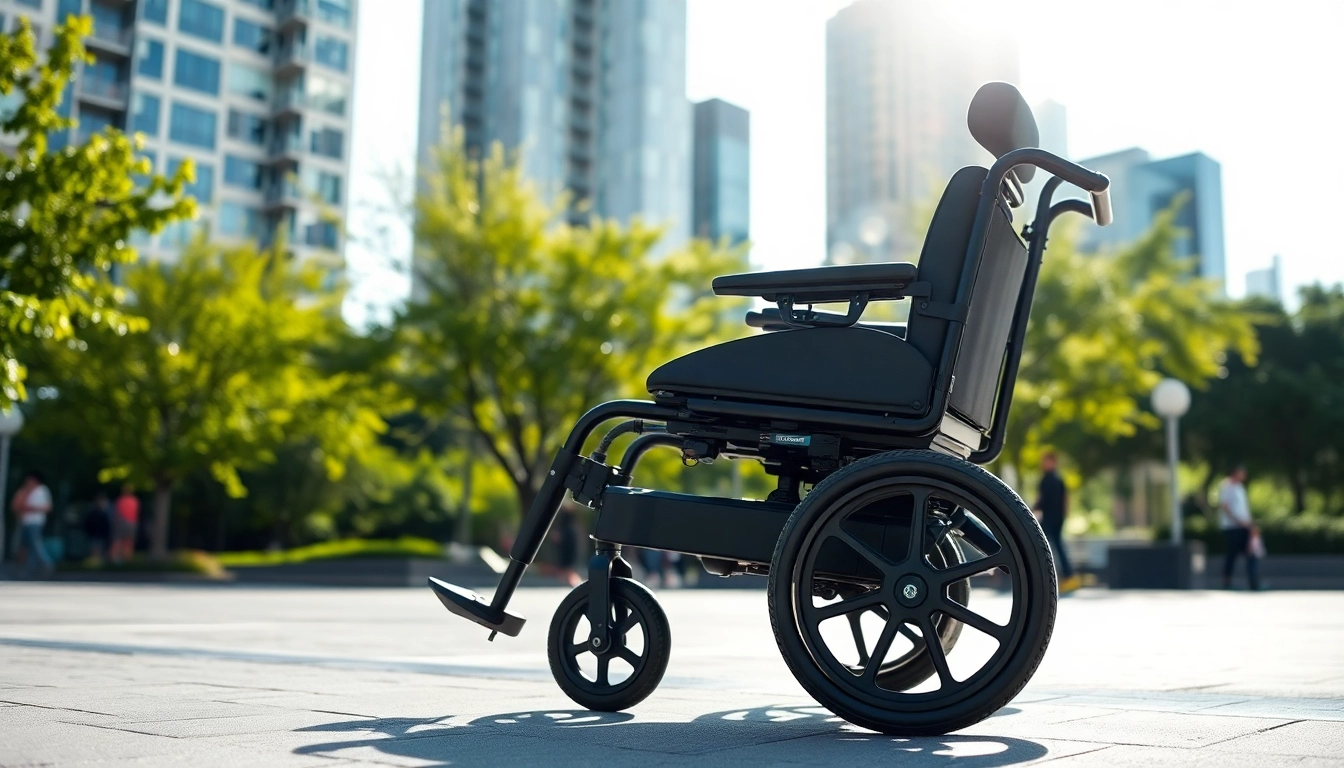Understanding Electric Wheelchairs
Electric wheelchairs, often referred to as power wheelchairs, represent a significant innovation in mobility aids, providing users with enhanced independence and support. Unlike manual wheelchairs, these devices boast a battery-powered motor that enables easy navigation across various terrains, making them ideal for individuals with limited mobility. Electric wheelchairs are tailored to meet diverse needs, from everyday commuting to specialized purposes, making them essential tools for many people. This section delves into the fundamental aspects of electric wheelchairs, covering their definitions, types, and operational mechanisms.
What is an Electric Wheelchair?
An electric wheelchair is a mobility device powered by a rechargeable battery, offering users a more effortless means of movement compared to manual wheelchairs. These wheelchairs come equipped with electric motors, which can be operated via a joystick or other control mechanisms. Electric wheelchairs have significantly improved the quality of life for individuals with mobility impairments, enabling them to perform daily activities with greater ease. Features often include adjustable seating, powered tilt, and recline capabilities, as well as various customization options to suit individual preferences and needs.
Different Types of Electric Wheelchairs
Electric wheelchairs can be categorized into several types, each designed with specific user needs in mind. Understanding the different types can help potential users make informed decisions:
- Standard Electric Wheelchairs: Ideal for everyday use, these models typically offer a balance between performance and comfort, suitable for both indoor and outdoor navigation.
- Heavy-Duty Electric Wheelchairs: Designed for larger individuals or those requiring additional support, these models boast enhanced weight capacity and durability.
- Travel Electric Wheelchairs: Lightweight and foldable, these models are perfect for individuals who travel frequently, offering portability without compromising quality.
- Multi-Purpose Electric Wheelchairs: These models feature configurable designs, allowing users to modify their wheelchair to suit various activities, such as sports and social events.
- Power Tilt and Recline Wheelchairs: Equipped with advanced features that allow users to adjust the seat’s position for comfort and medical needs, promoting better posture and circulation.
How Electric Wheelchairs Work
The operation of electric wheelchairs relies on several key components including a motor, battery, and control system. The user can navigate the wheelchair through a joystick or other input device which sends signals to the motor. Upon receiving these signals, the motor activates, propelling the wheelchair forward, backward, or turning as directed. The battery powers the entire system, typically providing several hours of continuous use before requiring a recharge. Each electric wheelchair has a specific range and speed, defined by its design and battery capacity, which is crucial for users to consider in relation to their daily activities and lifestyle.
Benefits of Using an Electric Wheelchair
Choosing an electric wheelchair offers numerous advantages that can significantly enhance an individual’s lifestyle. Below are some of the core benefits associated with their use:
Enhanced Mobility and Independence
One of the clearest benefits of using an electric wheelchair is the enhancement of mobility. These devices allow users to navigate their environment with minimal effort, promoting greater independence. Whether it’s shopping, attending social gatherings, or simply moving around the house, electric wheelchairs empower individuals to engage in daily activities without relying on assistance. Advanced technology and user-friendly controls facilitate seamless transitions between indoor and outdoor environments, ensuring users maintain active lifestyles.
Improved Quality of Life
The impact of electric wheelchairs on quality of life goes beyond physical mobility. They contribute to psychological well-being by fostering a sense of freedom and autonomy. Users often report increased social interaction, reduced feelings of isolation, and a stronger connection to their communities. Additionally, the comfort and ergonomic designs of electric wheelchairs can alleviate physical discomfort associated with extended periods in traditional seating, enhancing overall satisfaction and daily functionality.
Customizable Features for Comfort
Electric wheelchairs come with various customizable features tailored to individual needs, including adjustable seating, lumbar support, and armrest configurations. This degree of personalization allows users to achieve optimal comfort while also meeting specific medical requirements. By incorporating features such as powered tilt or recline, users can adjust their position easily to enhance circulation, prevent pressure sores, and ensure comfort during extended use.
Key Features to Consider
When selecting an electric wheelchair, it is crucial to evaluate several key features that directly impact performance, comfort, and safety. Below are the essential aspects to consider:
Battery Life and Range of Electric Wheelchairs
Battery life and range are fundamental for any electric wheelchair. Users should assess how far they typically travel in a day, as electric wheelchairs can vary widely in range based on battery size and motor efficiency. A wheelchair with a longer battery life provides peace of mind for users engaging in extended outings. Moreover, understanding charging times and battery lifespan is essential for maintenance, ensuring the wheelchair remains operational and reliable.
Adjustability and Comfort Options
The adjustability of an electric wheelchair greatly impacts user experience. Features such as adjustable seat height, depth, backrest angle, and leg rests all contribute to overall comfort. It’s vital for users to test these features to ensure they meet their specific physical requirements, particularly if they have particular medical assessments related to posture or mobility. Proper adjustment can lead to reduced fatigue and longer periods of comfortable use.
Safety Features to Look For
Safety is a top priority when it comes to electric wheelchairs. Essential safety features include reinforced frames, anti-tip systems, secure braking mechanisms, and reflective materials or lights for visibility. Many modern electric wheelchairs come equipped with advanced technology, including obstacle detection sensors, speed controls, and emergency stop functions. Prospective users should prioritize safety features to ensure they can navigate their environments securely and confidently.
How to Choose the Right Electric Wheelchair for Your Needs
Choosing the right electric wheelchair involves careful consideration of various factors that align with the user’s lifestyle, preferences, and financial situation. Here’s how to proceed:
Assessing Your Lifestyle and Usage
Understanding personal lifestyle needs is the first step in selecting an electric wheelchair. Users should consider how often they will use the wheelchair, the types of environments they will navigate (such as indoors vs. outdoors), and specific mobility challenges unique to their circumstances. This assessment helps to narrow down options based on required features like portability, terrain adaptability, and specific power needs.
Budget Considerations for Electric Wheelchairs
Electric wheelchairs come in a range of price points, and budget plays a crucial role in the decision-making process. Users should define their budget early, considering both the initial purchase price and any ongoing expenses such as maintenance or battery replacements. Additionally, it’s important to explore potential financial assistance options, such as health insurance coverage or funding programs that can help offset costs.
Testing and Trialing Options
Whenever possible, users should take the opportunity to test various electric wheelchair models before making a purchase. Many retailers offer trial periods or demo sessions, allowing users to assess comfort, control, and maneuverability within their typical environments. This hands-on approach can aid in selecting a wheelchair that feels right, as personal comfort is paramount to satisfaction and usability.
Real-life Experiences with Electric Wheelchairs
To fully understand the benefits and challenges of electric wheelchairs, it’s valuable to examine real-life experiences. Testimonials and case studies can shed light on the diverse applications of electric wheelchairs in everyday life.
Case Studies and Testimonials
Numerous users testify to the transformative impact of electric wheelchairs. For example, a case study of an individual with mobility impairments illustrated how transitioning from manual to electric mobility aid allowed for greater independence. They found that they could participate in family activities, attend social gatherings, and coalesce with peers, fundamentally changing their social dynamics and personal fulfillment. These positive outcomes encourage individuals to explore electric wheelchairs as viable mobility solutions.
Challenges Faced by Users
While electric wheelchairs offer significant benefits, users may encounter challenges, particularly in navigating uneven terrains or dealing with battery limitations. Additionally, some users may face hurdles in integrating their electric wheelchair into daily life—such as transportation issues or spatial constraints within their home. Acknowledging these challenges upfront allows potential users to strategize solutions, ensuring a smoother transition to electric mobility.
Future Trends in Electric Wheelchair Technology
The future of electric wheelchairs is promising, with emerging technologies poised to enhance user experience further. Innovations such as smart navigation systems, artificial intelligence for personalized mobility assistance, and IoT connectivity can improve overall performance and versatility. Furthermore, advancements in lightweight materials and energy-efficient batteries could pave the way for even more user-friendly designs. Keeping abreast of these trends will empower users to make informed decisions and leverage the latest in mobility technology.



